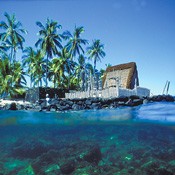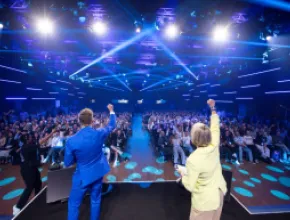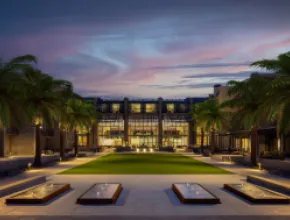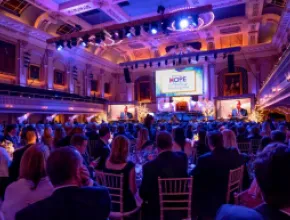Aheadline of a meetings promotional piece from the Big Island of Hawaii proclaims, “It’s out of your world.”
Indeed, Hawaii’s “Island of Adventure” is a departure from the norm when it comes to tropical destinations, and its unique attributes combined can make it seem like another planet—a lava-oozing volcano that has been putting on quite a show this year; snow-capped mountains; rain forests with interesting ecosystems; enticing palm-fringed beaches; ranching and coffee regions; and a rich Polynesian legacy.
The Hawaiian chain’s largest island, which boasts 11 of the world’s 13 climate zones, has a staggering diversity that lends itself to new cultural, sightseeing and team-building experiences. And everything in this “mini-continent” is neatly packaged within a 260-mile highway that circles the island.
“We’re a happening destination for groups with a fresh and upgraded product and lots of activities that other islands don’t have,” says Debbie Hogan, senior director of sales at the Big Island Visitors Bureau (BIVB). “The east side has the volcanoes and agriculture; the west side has the great resorts—the Kohala Coast, with four- and five-star hotels and plentiful meeting space, and the more affordable properties of Kona.”
Although the island is best known as an incentive destination, Hogan says it has a good mix of association business, taking groups of up to 3,000 people with destination resorts working together to attract business.
Valuable exposure comes this month, when the 11th annual PRIME (Pacific Rim Incentives & Meetings Exchange) takes place Sept. 9-14 at the Kohala Coast’s Waikoloa Beach Marriott, attracting 100 planners who will meet one-on-one with Hawaii suppliers. Since the inaugural PRIME was held on the Big Island in 1999, it has continued each year at the Hawaii Convention Center in Honolulu—until now.
“It’s a fantastic destination,” says Pris Texeira, managing director of PRIME. “Many planners don’t think of the Big Island as a CMI destination, but there’s a lot of product and services, upgraded resorts and meeting space, and new tours and activities.”
Kohala Coast
Turn north from Kona International Airport, and within 20 miles are four master-planned beachfront resorts carved from the sloping barren lava flows—first Hualalai Resort, seven miles from the airport, then Waikoloa Beach Resort, Mauna Lani Resort and Mauna Kea Resort, 27 miles away. Each resort development has two hotels, and together the resorts have 3,700 hotel rooms, seven championship golf courses and abundant indoor meeting space, in addition to a range of outdoor space for year-round alfresco events on a coast that gets less than nine inches of rain a year and averages temperatures of 79 in winter and 85 in summer.
From the highway, they stand out in the distance as tropical oases. Their preserved and restored archaeological sites—including the aquaculture fishponds of Hawaiian chiefs and petroglyph fields—attest to the ancient fishing villages that once sprinkled the coast and provide groups with hands-on opportunities to soak up ancient Hawaiian history.
The first properties to open in the region, both in 1965, were the legendary Mauna Kea Beach Hotel, built by Laurence Rockefeller, and Kona Village Resort at Hualalai, which has group space and has retained its thatched-roof hideaway identity without radios or televisions.
Mauna Kea Resort boasts two Prince Resorts Hawaii properties: Mauna Kea Beach Hotel and the 350-room Hapuna Beach Prince Hotel, with a combined 100,000 square feet of indoor and outdoor function space. Mauna Kea Beach Hotel is slated to reopen in December following a $150 million renovation. (The property closed Dec. 1, 2006, due to structural earthquake damage.) The property’s room inventory will be reduced from 310 to 258 with the construction of larger rooms. Its golf course, closed since May 2007, will reopen about the same time following a restoration.
To the south, Mauna Lani Resort is home to The Fairmont Orchid, with 540 rooms and 31,000 square feet of indoor meeting space, and the 350-room Mauna Lani Bay Hotel and Bungalows, with more than 29,000 square feet of function space.
Halfway between the airport and Mauna Kea, Waikoloa Beach Resort has the 1,240-room Hilton Waikoloa Village and the 545-room Waikoloa Beach Marriott Resort and Spa.
With dolphins, tram and waterway transportation, and 60,000 square feet of indoor meeting space, the Hilton has invested $100 million in improvements since 2005, while the 555-room Marriott completed a $50 million makeover in March 2007 that included renovations to its guest rooms, the new Mandara Spa and a new 12,000-square-foot ballroom, bringing the property’s total square footage of indoor meeting space to 27,800.
Last October, Waikoloa unveiled Queens’ MarketPlace and Cultural Gardens—28 acres of gardens, shopping and restaurants with daily Hawaiian entertainment and a 4,000-seat amphitheater. The current 30 retail and restaurant outlets will expand to more than 60 upon completion.
Farther south, the 243-room Four Seasons Resort Hualalai has a AAA Five Diamond rating and 26,000 square feet of meeting space. In May, the property began converting selected rooms in its 36 two-story bungalow-style buildings to suites. Upon completion of the project in July 2009, it will have increased its number of suites from 31 to 51.
There are plenty of distinctive ways for attendees to bond when meeting on the Kohala Coast. Groups can compete in a cook-off challenge at the Hilton, build a “little grass shack” at the Fairmont, climb a rock wall at the Four Seasons, or enjoy an evening of stargazing at the Marriott.
Spas add another dimension to the guest experience, and Hawaiian healing arts, including lomilomi massage and the use of native plants, are an integral part of pampering programs.
Meanwhile, off-site excursion options abound.
Kathy Clarke, of Kathy Clarke Hawaii, a local DMC, says ATV adventures, horseback riding, waterfall hikes, and picnic and sunset snorkel sails are the most popular half-day events.
The company’s offerings range from Mauna Kea summit astronomy observatory tours 13,796 feet above sea level to deep-sea fishing and coffee tours in Kona, and whale watching cruises from December through April.
“Some years ago you couldn’t sell a hike,” Clarke says. “Now eco-adventures are popular.”
With Kilauea Crater’s eruption, small-group demand for helicopter tours to the sites, which take up two hours, has increased, according to Clarke.
“It’s a huge source of interest, and of course people are looking for new and creative ways to see it,” she says.
Creating innovative tour combinations is a trend, and for groups, activities can always be customized.
From the west side, Blue Hawaiian Helicopters and Hawaii Forest & Trail launched a new eco-adventure this year, the Waterfall HeliHike, combining an air tour of the breathtaking windward coast cliffs with a two-mile hike, including a dip in a mountain stream. Up to 100 people broken up into small groups can be handled in a day.
Additionally, BigTi Tours has a new itinerary that combines a dolphin cruise from Kona’s Honokohau Harbor with a visit to Mountain Thunder Coffee Farm, the country’s largest organic coffee farm.
Meanwhile, a 20-minute drive east from Mauna Kea Resort and you are in paniolo (cowboy) country and Waimea town, home of Parker Ranch. One of the country’s oldest and largest ranches, it features a museum, historic home tours, horseback riding and wagon rides, and a rodeo arena that can accommodate gatherings of up to 2,000 people.
John Palmer Parker, who founded the ranch in 1847, was inducted into the National Cowboy & Western Heritage Museum’s Hall of Great Westerners in Oklahoma City April 12. With special exhibits and events in Hawaii (and on the mainland), the state proclaimed 2008 the Year of the Paniolo.
Kailua-Kona
Nine miles south of Kona International Airport is Kailua-Kona town, the Kona Coast’s hub and, with a population of 10,000, the island’s second-largest community.
Within walking distance are its two meetings properties: the 460-room King Kamehameha’s Kona Beach Hotel, with 5,200 square feet of meeting space, and the 436-room Royal Kona Resort, with more than 10,000 square feet of function space. King Kamehameha’s Kona Beach Hotel is under new ownership and is planning renovations.
Packed with galleries, boutique stores and restaurants, the town also has historic sites. An ancient heiau (temple) fronts the Kona Beach Hotel. Kamehameha the Great had his Big Island capital here before moving in 1795 to conquer Maui and Oahu. The oceanfront grounds of Hulihee Palace, a museum, built in the 1840s as the home of his descendants, is popular for functions.
Five miles south, Keauhou is a 2,400-acre community with two hotels, a shopping center and 36 holes of golf. Outrigger’s 309-room Keauhou Beach Resort, which completed a $6 million room renovation last spring, has 16,000 square feet of function space, and the 530-room Sheraton Keauhou Bay Resort & Spa features a 36,000-square-foot convention facility. The property, formerly the Kona Surf, reopened as a Sheraton in 2004 following a $70 million makeover.
Various cruises, including snorkeling and scuba outings, are available from nearby Keauhou Bay.
Historic sites south of town include the Puuhonua Ohonaunau (Place of Refuge) National Historic Park and Kealakekua Bay, where Captain Cook was killed in 1779.
Hilo and the Volcanoes
As the seat of Hawaii County, which encompasses the island, Hilo is the island’s largest community, with a population of 40,000. Flights into Hilo International Airport make the destination easily accessible, and in contrast to the western side of the island, the Hilo side, which receives more than 100 inches of rain a year, is lush and green, famed for its gardens, orchid farms and waterfalls, in addition to its coastline of black sand beaches.
The impenetrable jungle in Indiana Jones and the Kingdom of the Crystal Skull is actually in the Puna District south of Hilo. The filmmakers spent two months there in summer 2007 shooting scenes that included a chase along a steep coastal cliff.
Along a banyan-shaded drive across the bay from downtown are the town’s two meetings hotels: the 286-room Hilo Hawaiian Hotel, with 20,000 square feet of meeting space, and the 390-room Naniloa Volcanoes Resort, which features 12,000 square feet of function space and is in the midst of a $10 million renovation that includes enhancements to guest rooms and meeting facilities.
Hilo’s newest attraction and function venue is the $28 million Imiloa Astronomy Center of Hawaii, which opened in 2006 on the University of Hawaii at Hilo campus. It includes a 120-seat planetarium, a 2,500-square-foot exhibit hall that can hold 360 people, and a 90-seat restaurant.
Additionally, the university has 20,000 square feet of rentable space, including a 600-seat performing arts theater. Its conference services department, experienced in arranging international scientific conferences, most at the island’s hotels and resorts, provides meeting planning services ranging from securing speakers and Hawaiian culture experts to eco-tours.
A 30-minute drive from Hilo brings visitors to the heart of the 333,000-acre Hawaii Volcanoes National Park, with its contrasting vistas of lush forest and lava moonscapes. An 11-mile road circling Kilauea Crater, 4,000 feet above sea level, features attractions overlooking the rim such as the historic Volcano House Hotel, the Volcano Art Center and the Jaggar Museum.
Kilauea’s 25-year eruption experienced a year-long hiatus until it came to life again in February, breaking out in a remote area of its east rift zone with lava pouring into the ocean about 25 miles from park headquarters. Then in March, Halemaumau Crater, part of Kilauea Crater, erupted for the first time since 1924 (except for a brief eruption in 1982 that lasted less than 24 hours).
Chris Colvin, sales and marketing manager at Hawaii Forest and Trail, says demand by groups for the company’s 10-hour volcanoes tour from the west side has increased.
The best place for viewing Halemaumau, he says, which emits a continuous sulphur plume and glows red at night, is by the Jaggar Museum, which overlooks the crater and is where the U.S. Geological Survey maintains a webcam.
For the best coastal show, near the point where lava steams into the ocean, Hawaii County maintains a viewing area outside the park boundary along the coastal highway. The viewing area is open daily from 2 p.m. to 10 p.m.
The coastal display has prompted the creation of new tour offerings: Volcano Bike Tours has a new guided bicycle tour that includes lunch at the village of Kalapana and the volcano viewing area; Lava Ocean Adventures offers daily sunset and sunrise cruises from the Hilo area to the lava outpouring.
For More Info
Big Island Visitors Bureau 808.961.5797 www.meetbigisland.com
Hawaii Visitors and Convention Bureau 808.923.1811 www.meethawaii.com
Kohala Coast Resort Association 808.886.4915 www.kohalacoastresorts.com






